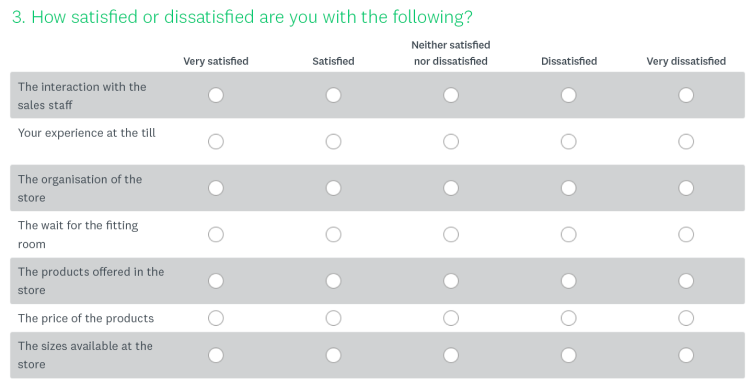Survey question types: Examples and tips from experts
Questions shape answers, so choose carefully! Open-ended questions explore, whereas close-ended questions confine: which type will unlock your survey’s full potential?

Are you looking for insights? It’s important to start off on the right foot. The way in which you obtain information and the survey questions that you use play a big role in a successful survey.
Before you rush into writing your survey questions, ask yourself how you intend to use the answers from your survey. Are you going to ask direct questions? What about categorical questions? Once you know the goals of your survey and the information you’d like to collect, you’ll be able to choose survey question types easily.
Survey questions can use either a closed-ended or open-ended format to collect answers from individuals. And you can use them to gather feedback from a host of different audiences, including your customers, colleagues, prospects, friends and family.
Note: A closed-ended question includes a predefined list of answer options, while an open-ended question asks the respondent to provide an answer in their own words.
Before you decide on the different types of survey questions to use, let’s review each of your options. The best types of survey questions include:
What are the different types of popular survey questions?
Below are some of the most commonly used survey question types and how they can be used to create a great survey. To see what each type of survey question might look like, visit the sample survey questions page.
Multiple choice questions
Multiple choice questions are the most popular survey question type. They allow your respondents to select one or more options from a list of answers that you define. They’re intuitive, easy to use in different ways, help produce easy-to-analyse data and provide mutually exclusive choices. Because the answer options are fixed, your respondents will have an easier survey-taking experience.
Perhaps, most importantly, you’ll get structured survey responses that produce clean data for analysis.
Multiple choice questions come in many different formats.
The most basic variation is the single-answer multiple choice question. Single-answer questions use a radio button (circle buttons representing options in a list) format to allow respondents to click only one answer. They work well for binary questions, questions with ratings or nominal scales.
Here’s how a single-answer question can look:

Multiple-answer multiple choice questions are commonly shown with square tick boxes. They allow respondents to tick all the choices that apply to them. For example, "In which of the following ways do you use our product?"
A common drawback of multiple choice questions is that they force you to limit responses to a predetermined list of options. This can cause bias in your results. What if none of your answer options apply to your respondents? They might just choose a random answer, which could have an impact on the accuracy of your results.
You can solve this problem by adding an “other” answer option or comment field. It should be listed at the end of all your choices. When respondents see it, they know they have the option of answering your question in their own words instead of yours.

Send your survey to a large or small group of people with our online Audience panel.
Rating scales
In rating scale questions (sometimes referred to as ordinal questions), the question displays a scale of answer options from any range (0 to 100, 1 to 10, etc.). The respondent selects the number that most accurately represents their response.
Net Promoter Score® questions are a good example of rating scale questions. They use a scale to gauge how likely customers would be to recommend their product or service.

With ranking questions and numerical rating scales, it’s important to give the respondent some context. For instance, imagine you asked the question “How much do you like ice cream?” If you don't explain the value of the numbers on your scale, a numerical rating scale might not make much sense.
Likert scales
Chances are you’ve seen this question type before. Likert scale questions are the “Do you agree or disagree?” questions that you often see in surveys and are used to gauge respondents’ opinions and feelings.
Likert scale questions give respondents a range of options, for example starting at “not at all likely” and scaling all the way up to “extremely likely”. That’s why they work well to understand specific feedback. For example, survey questions for employees often use a Likert scale to measure their opinions or attitudes on a range of topics.

Matrix questions
If you want to ask a few questions in a row that have the same response options, then matrix questions are your best option. A series of Likert scale questions or a series of rating scale questions can work well as a matrix question. Matrix questions can simplify a lot of content, but it’s important to use them carefully. Very large matrices, like the one below, can be confusing and difficult to take on mobile devices.

Dropdown questions
The dropdown question is an easy way to display a long list of multiple choice answers without overwhelming your respondents. By using this, you can give them a scrollable list of answers to choose from.

Sometimes, showing all answer options at once can offer your respondents useful context about the question. Bear that in mind whenever you consider using more than one dropdown question in your survey.
Open-ended questions
Open-ended survey questions require respondents to type their answer into a comment box and don’t provide specific pre-set answer options. Responses are then viewed individually or by text analysis tools.
When it comes to analysing data, open-ended questions aren’t the best option. It’s not easy to quantify written answers which is why text boxes are better for providing qualitative data. Allowing your respondents to offer feedback in their own words could help you uncover opportunities that you may have otherwise overlooked. However, if you’re looking for data to analyse, you may want to engage in some quantitative marketing research and utilise closed questions.
Pro tip: Pair closed-ended questions with open-ended ones to better understand and address your quantitative data. For example, after the Net Promoter question, you can ask:

Demographic questions
Use demographic survey questions if you’re interested in gathering information about a respondent’s background or income level. When properly used, these types of questions in a questionnaire allow you to gain better insights into your target audience. Demographic questions are powerful tools for segmenting your audience based on who they are and what they do, allowing you to delve even deeper into your data.
Classic demographic questions ask for information such as age, gender and occupation. They can even ask for the respondent’s relationship status:

Once you get the hang of survey question types, you’ll soon start to get the most out of your data. Learning which survey question type to use helps you focus on the most important information you need from respondents. Until then, you can use our survey creation tools to help you choose the best questions for your survey.
Ranking questions
A ranking question asks respondents to order answer choices according to preference. This allows you to not only understand how respondents feel about each answer option, but it also helps you understand each one’s relative popularity.
It’s important to bear in mind the fact that ranking questions can take more time to answer. So try not to use them if other question types can provide the data you need. Also, only use them when you’re confident that respondents are familiar with each answer option; otherwise, they’ll be nigh on impossible to answer accurately and honestly.
For instance, in the question below, respondents need to be familiar with each show before they can compare them.

Image choice questions
Our image choice question type allows you to use images as answer options. This works really well when you want respondents to evaluate the visual qualities of something, such as an ad or a logo. It can also provide a breath of fresh air for respondents, as it gives them a break from reading.

Click map questions
Want to get real-time, gut-reaction feedback on an image? Use a click map question! Add an image to your survey and ask survey-takers to click a certain spot on the image. For example, you could ask which item on a shelf is most appealing or which part of your website is most user-friendly.

File upload questions
Do you need respondents to upload their CV? A headshot? Their ID? You can collect whatever you need as a PDF, PNG or doc file, and when your responses come back, you can easily download the files.

Slider questions
Give respondents a chance to evaluate something on a numerical scale with our slider question type. They’re interactive, which can make them fun to answer, and they allow you to quantify respondent sentiment at both an individual and aggregate level.

Benchmarkable questions
Benchmarkable questions aren’t necessarily presented in a specific format, but they’re special in that they allow you to compare yourself to other survey creators who asked the same question.
Benchmarkable questions range widely, and they can be used for different audiences (employees, customers, etc.). To find one for your survey, you can either use our question bank or one of our survey templates. If a question has a small bar chart icon at the top, this means that it’s benchmarkable.

3 tips for writing great survey questions
Now that you know the different survey questions examples, you’re ready to start creating your survey! Here’s some advice to bear in mind as you begin:
Use the questions our experts have written
Creating a great survey doesn’t have to be difficult. Don’t let the design of a questionnaire throw you. You could create one in minutes by choosing from one of our hundreds of free, expert-designed survey templates built by our in-house subject-matter experts and survey scientists.
Prefer to create a survey from scratch? Use our Question Bank to start populating your survey with ready-made questions that can help you get the answers you need. Either way, you can count on having a survey that our methodologists say will leave you with unbiased results.
Ask mobile-friendly questions
Are your surveys ready to go mobile? Roughly three in 10 people taking SurveyMonkey surveys in the U.S. do so on a smartphone or tablet. Here’s a quick checklist about the different survey questions you should ask and how to format your survey to ensure that it’s mobile-optimised and mobile-friendly.
- Use mostly multiple choice questions in your survey
- Limit the number of questions on each page
- Keep surveys as short as possible to minimise dropouts
- Only require responses to your most important questions
- Keep survey formatting simple, avoiding progress bars or logos as they take up valuable space
- Avoid using images as they take up valuable space on small screens
- Test your survey on different mobile devices
- Keep your survey URL short and easy to read so it can be linked anywhere
See what others think of your survey
We can all benefit from someone proofreading our work. Surveys are no exception.
Share your survey with colleagues, friends, family and anyone else who has a vested interest in its success before you send it. You never know, they might be able to help you spot errors or areas for improvement.
It’s important to know which survey question type to use and when to use it. Once you’re familiar with different survey questions, you’ll be able to focus on what you need from respondents, getting you far better data than ever before.
Discover more resources

Customer satisfaction survey templates
Explore our customer satisfaction survey templates to rapidly collect data, identify pain points and improve your customer experience.

How to identify customer needs
Refine your market research approach with our guide to identifying customer needs and what UK shoppers are looking for in 2024.

See how woom enhances its employee and customer experience
Discover how woom uses SurveyMonkey to launch multilingual surveys at scale, improve the employee experience and capture customer insights.

How the SurveyMonkey Salesforce integration helps you improve CX scores
How to combine the power of Salesforce customer data with the feedback capabilities of SurveyMonkey to improve CX.
Ready to start sending your first survey?
SurveyMonkey can help you shape your surveys by assisting you in choosing the best types of questions based on your needs.